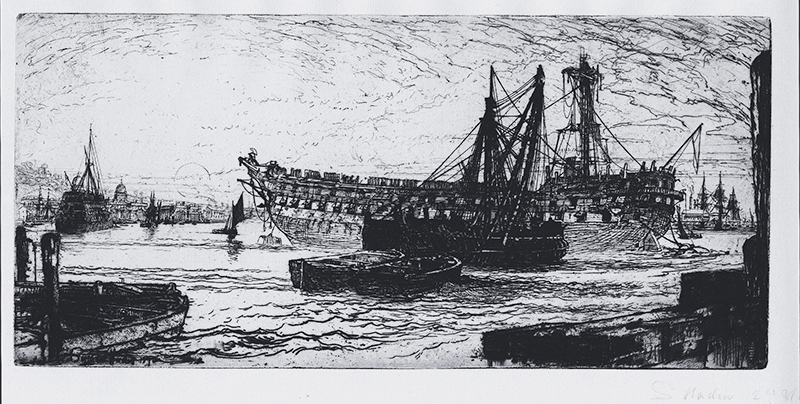
19th, 20th & 21st Century Fine Prints
707-546-7352 · fax 707-546-7924 · web: www.annexgalleries.com · email: artannex@aol.com
Breaking Up of the Agamemnon No 1 by Francis Seymour Haden

Breaking Up of the Agamemnon No 1
Francis Seymour Haden
Breaking Up of the Agamemnon No 1
Francis Seymour Haden
1818 - 1910 (biography)Considered by many to be the single most important subject of Sir Francis Seymour Haden's career, Breaking up of the Agamemnon, No.I was proved by Haden, printed by the foremost plate printer of the day, Frederick Goulding, and was issued by the artist himself through Colnaghi Gallery in London - with immense success. American print dealer Frederick Keppel claimed that the print sold 10,000 copies, though around 500 seems more reasonable. The first state appears to have been done in an edition of between 50 and 100 proofs.
This proof is annotated "2nd State" by Haden after his signature. Most catalogers list only two states for this image, but Schneiderman lists eleven. Whether this state is the second of two or eleven is open to discussion.
Early in 1870, P.G. Hamerton had approached Seymour Haden to etch a plate for his newly-founded art magazine, The Portfolio. Haden chose this subject of the hulk of the warship HMS Agamemnon as she lay moored at the Naval Arsenal at Deptford (on the Thames) for demolition. One of the last wooden-hulled warships built in England, launched in 1852, the Agamemnon had served as the flagship in many naval battles and in 1857 had been a participant in the laying of the Atlantic telegraph cable. To her left, in front of the Royal Hospital at Greenwich, is seen one of the iron-clad battleship queens of the British Royal Navy at the time, replaced soon after by the dreadnoughts.
Haden "drew" the initial sketch for this etching directly on the prepared copper plate. He wrote to Hamerton: "I had thought of making the sun set behind the old hulk and the distant cupolas of Greenwich and of using the sinking luminary as typical of the departing glories of both..."
The plate was one of Haden's largest and was deemed too large to publish in The Portfolio and was then published by the artist himself and Colnaghis.
